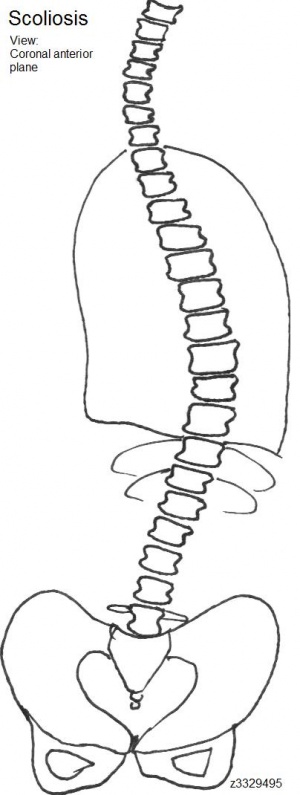2011 Group Project 8: Difference between revisions
| Line 38: | Line 38: | ||
==Clinical Presentation== | ==Clinical Presentation== | ||
===Symptoms=== | ===Symptoms=== | ||
Friedreich's Ataxia (FA) often manifests before puberty to early adulthood. Physical complaints such as chest pains <ref name="PMID:7488466"><pubmed>7488466</pubmed></ref>, progressive gait and limb ataxia, absent lower limb reflexes, extensor plantar responses (Babinski's sign), dysarthria, reduction in or loss of vibration sense and proprioception <ref name="PMID:10633128"><pubmed>10633128</pubmed></ref>, <ref name="PMID:13872187"><pubmed>13872187</pubmed></ref>. | Friedreich's Ataxia (FA) often manifests before puberty to early adulthood. Physical complaints such as chest pains <ref name="PMID:7488466"><pubmed>7488466</pubmed></ref> <ref name="PMID:3593615"><pubmed>3593615</pubmed></ref>, progressive gait and limb ataxia, absent lower limb reflexes, extensor plantar responses (Babinski's sign), dysarthria, reduction in or loss of vibration sense and proprioception <ref name="PMID:10633128"><pubmed>10633128</pubmed></ref>, <ref name="PMID:13872187"><pubmed>13872187</pubmed></ref>. | ||
'''scoliosis''', foot deformity ('''pes cavus''', hammer toe) and cardiomyopathy are common but not symptoms which FA is often diagnosed by<ref name="PMID:10633128"><pubmed>10633128</pubmed></ref>. | '''scoliosis''', foot deformity ('''pes cavus''', hammer toe) and cardiomyopathy are common but not symptoms which FA is often diagnosed by<ref name="PMID:10633128"><pubmed>10633128</pubmed></ref>. | ||
Revision as of 14:23, 27 August 2011
| Note - This page is an undergraduate science embryology student group project 2011. |
Your Project Goes Here.
2011 Projects: Turner Syndrome | DiGeorge Syndrome | Klinefelter's Syndrome | Huntington's Disease | Fragile X Syndrome | Tetralogy of Fallot | Angelman Syndrome | Friedreich's Ataxia | Williams-Beuren Syndrome | Duchenne Muscular Dystrolphy | Cleft Palate and Lip
Friedreich’s Ataxia
Introduction
Friedreich’s Ataxia (FRDA) is an extremely debilitating progressive neurodegenerative disease. FRDA, an autosomal recessive disorder, is the most common of the inherited ataxias and affects an estimated 1 in 50000 people. [1] [2] Generally, FRDA is not diagnosed until the patient reaches their second decade of life, around the time of puberty, in which ataxic gait becomes noticeable. Progressive weakness is also noticeable due to loss of skeletal muscle, which can cause pateints to become wheelchair bound with in 10-15 years of onset of the disease. [2] The disruption of the frataxin gene is often caused by a trinucleotide repetition of GAA, which is located on chromosome 9q. [1] The result of this gene is a mitochondrial protein, frataxin, which is known to play a role in iron homeostasis. [3] This causes major disabilities in the tissues containing the fraxtain deficient mitochondria, such as skeletal and cardiac muscle, as well as, the central and peripheral nervous systems. [4] The results of FRDA involve an increase chance of developing diabetes mellitus and premature death due to congestive cardiac failure and cardiac arrhythmia. [3] [5] [6]
History
Nikolaus (Nicholas) Friedreich (1825-1882) was born into a family of physicians and studied medicine at the University of Würzburg, Germany. Pathology and neurology were his main interests in medicine and in 1858 he became the director of medicine at the Heidelberg medical clinic. [2] [7] During his years at Heidelberg he became intrigued with the clinical presentation of some of his patients who he described as having “degenerative atrophy of the posterior columns of the spinal cord that could affect several children of unaffected parents”. [2] In 1863, Friedreich wrote his first journal article on his findings about six of his patients who belonged to two separate families. These patients presented with similar clinical signs and with his continued research Friedreich collated the symptoms of ataxic gait, sensory loss, dysarthria, skeletal muscle weakness, foot irregularities, scoliosis and cardiac abnormalities linking there cause to a common factor. [3] [7] Friedreich proceeded to write several articles on the disease, which now bares his name Friedreich’s Ataxia.
Timeline
Epidemiology
Distribution - FRDA is the most common form of inherited ataxic disease, with an estimated 1 in 50,000 people affected. [3] [1] [2]
- Populations - It has been noted that Caucasian populations have a higher prevalence of FRDA with approximate carrier frequencies varying between 1:50 to 1:100. [8]
Furthermore, Sub-Saharan, Asian and African populations have a much lower incidence of FDRA. [8] [3]
Aetiology
Genetic Component
Inheritance
Genetic Expression
Pathogenesis
Pathophysiology
Clinical Presentation
Symptoms
Friedreich's Ataxia (FA) often manifests before puberty to early adulthood. Physical complaints such as chest pains [9] [10], progressive gait and limb ataxia, absent lower limb reflexes, extensor plantar responses (Babinski's sign), dysarthria, reduction in or loss of vibration sense and proprioception [11], [12]. scoliosis, foot deformity (pes cavus, hammer toe) and cardiomyopathy are common but not symptoms which FA is often diagnosed by[11].
Complications
Diagnosis
Friedreich's Ataxia (FA) is often diagnosed based on presenting clinical symptoms but testing for the gene defect that causes it is taken as a definitive diagnosis.
| Availability of genetic testing | Diagnostic symptoms |
| Prior to genetic testing availability | Only physical complaints, age of onset and typical FA progression could identify it as FA. |
| After genetic testing is available | Physical complaints are used in conjunction with genetic testing to confirm FA. Due to genetic testing, [13]it has been discovered that FA can occur in individuals older than the typical diagnostic age (first two decades of life[14]). |
A paper on cardiac evaluation of Friedreich's Ataxia patients found that cardiac evaluation was a useful tool to compliment genetic testing in terms for screening for patients who should be tested for Friedreich's Ataxia[15]
Treatment
Genetic Screening
Current Research
References
- ↑ 1.0 1.1 1.2 <pubmed>11351269 </pubmed> Cite error: Invalid
<ref>tag; name 'PMID11351269' defined multiple times with different content - ↑ 2.0 2.1 2.2 2.3 2.4 <pubmed>19283344</pubmed>
- ↑ 3.0 3.1 3.2 3.3 3.4 <pubmed>10633128</pubmed>
- ↑ <pubmed>12547248</pubmed>
- ↑ <pubmed>10607838</pubmed>
- ↑ <pubmed>5673214</pubmed>
- ↑ 7.0 7.1 <pubmed>15090560</pubmed>
- ↑ 8.0 8.1 <pubmed>21315377</pubmed>
- ↑ <pubmed>7488466</pubmed>
- ↑ <pubmed>3593615</pubmed>
- ↑ 11.0 11.1 <pubmed>10633128</pubmed>
- ↑ <pubmed>13872187</pubmed>
- ↑ <pubmed>21315377</pubmed>
- ↑ <pubmed>19283344</pubmed>
- ↑ <pubmed>12045843</pubmed>
External Links
Video Showing Ataxic Gait [1]
Glossary
Ataxic Gait - Involves a wide-based stance, lack of muscle coordination, errors in range and force of movement, delay in initiating movement.
Cardiac Arrhythmia - Abnormal rate or beat of the heart, which can be either fast (tachycardia) or slow (bradycardia).
Dysarthria -Slurring of speech.
FRDA - Friedreich's Ataxia.
Scoliosis - Abnormal curving of the spine in the Coronal plane to form an 'S-shpe' when viewed from the front.
Pes cavus - Feet with abnormally high arches.

